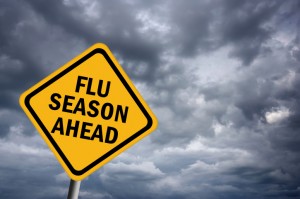In spite of the humorous twist on a weather report in this blog title, the statistics for the Flu in the New Year remain serious. According to the CDC, 43 states are experiencing either high or widespread flu activity.
According to the CDC, 43 states are experiencing either high or widespread flu activity.
Turning closer to home, the Orlando area has been hit hard. The Florida Lung, Asthma and Sleep Specialists have no doubt that many Floridians had their Christmas and New Year Holidays ruined with high fevers, coughs and body aches.
The Orlando Sentinel reported recently, “It’s been three weeks now since flu activity has become widespread in Florida and its activity is not abating: 39 counties, including Seminole, Orange, Lake, Polk and Osceola, are reporting increasing flu activity, according to the latest weekly report from the state health department.”
Know Your Enemy
Nationally, the CDC tracks many statistics during flu seasons, and has been collecting data since 2003. Their experts know that the near epidemic disease has been spread over the United States from the circulation of H3N2 viruses.
Statistically this is significant to the CDC (Center For Disease Control) because it can be compared to other flu seasons, and experts can trace similar trends throughout recent years.
Doctor’s Visits
For example, “patient visits to doctors for influenza-like-illness (ILI) are now almost even with the peak of 2012-2013 season.” 
Ironically the 2012-2013 season was the last time H3N2 viruses predominated.
Likewise, the relatively “higher flu hospitalization rates, seen so far this season, are similar to what has been observed during some past H3N2-predominant seasons.”
If we take a quick look back at the last week of 2014, data reveals that “overall flu-related hospitalizations were 12.6 per 100,000 people.” This is quite comparable to the 13.3 flu-related hospitalizations per 100,000 people seen during the same week of the 2012-2013 Flu Season, which was also dominated by H3N2.
In contrast, the flu-related hospitalization per 100,000 people was only 8.952 per 100,000 people in 2013-2014, a Season which was dominated by a different strain of flu virus, H1N1. Such data helps scientists understand flu viruses, epidemic tendencies and develop flu vaccines.
Attention: Over 65 Years Of Age!
If you are in the high risk group of people over 65, you should be aware that hospitalization rates for Flu and Flu complications are usually higher among people 65 years and older.
During week 52 of 2014, the hospitalization rate for people 65 and older was 51.8 per 100,000 people. During week 52 of the 2012-2013 season, the hospitalization rate for people 65 and older was 52.8 per 100,000.
By the end-of-the-flu-season, 2012-2013 hospitalization rate for people 65 and older was 183.2 per 100,000, a cringe-worthy, statistic, for sure. We will see what the end of our current season brings, but one thing is certain: If you are over 65, the experts at FLASS hope you have had your flu shot.
The Value of a Flu Shot: Priceless

Contagious couple suffers with flu symptoms.
Recent studies on vaccine effectiveness by CDC researchers have indicated that flu vaccine reduces your risk of a doctor visit due to flu by approximately 60%.
This is under the best conditions, meaning this high margin is attained when the vaccine viruses in your “Flu-Shot” are like the ones spreading in your community.
If the viruses in the vaccine are different from circulating flu viruses in your area, (because they drifted, in the language of the CDC,) vaccine effectiveness can be lowered. However, keep in mind that even in this case, the shot is valuable.
“CDC continues to recommend flu vaccination even when there are drifted viruses circulating because the vaccine can still prevent infection and also prevent serious flu-related complications in many people.”
FLASS and the CDC urge anyone who has not gotten vaccinated yet this season to do so now.
The CDC Forecast
Nationally we will still endure several more weeks of flu activity. The disease will progress into more states before it’s finished. The CDC reports, “Activity has been elevated in the Southern states for six weeks now.”
They add, “The mid-west saw increases in activity more recently. Most of the northeast and west of the country has yet to experience the full brunt of the flu season.”
Meanwhile, as we wait for this storm of infection to blow over, remember your doctor can prescribe anti-viral medicines that will ease your symptoms somewhat, and help prevent complications. Anti-viral drugs are especially effective in the first 48 hours, so if you think you have the flu, call your doctor right away.
Thank you for beginning the new year by reading the Florida Lung, Asthma, and Sleep Specialists’ blog. We hope you will return for our next installment of this special series dedicated to helping you through Flu Season. Remember, if you have not yet taken it, getting that Flu Shot might be the most important thing you do to welcome your new year!

